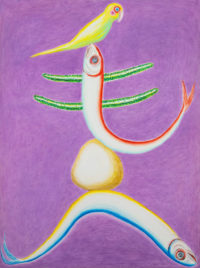
2023.07.22 – 09.02
Opening hour: 12.00-18.00
Closed on Sun, Mon, National holiday, between 08.12 – 21
Scarecrow
Almost half a century ago, maybe when I was in junior high school (my memory is hazy), I watched a movie starring Al Pacino and Gene Hackman. It was a dismal tale of a couple of scruffy vagabonds drifting around rural America, and the title, Scarecrow, somehow stuck in my mind. The English word meant nothing to me at the time, and perhaps I was simply drawn to the sound. The film portrayed the misery and rage of outcasts, men who society scorned as hoodlums or drunken bums, and it conveyed the atmosphere of present-day America, which seemed extremely remote and exciting to a Japanese kid from the sticks. At that time many movies coming out of the West revolved around outlaw stories like this, and I think they may have had a profound impact on my adolescent mentality.
It was not until much later that I learned the meaning of “scarecrow,” which is kakashi in Japanese. After that, when I was in art school, I saw The Wizard of Oz, and the brainless scarecrow character made a lasting impression on me. I’m not sure why this was, but it may have resonated with some void or absence I perceived within myself. I may have unconsciously projected myself onto that straw man. I think it was around that time that I finally made the connection between kakashi and “scarecrow.”
Be that as it may, when used in a metaphorical sense the implications of the word are rarely positive. We picture a lonely outcast standing around idly, someone useless and incompetent despite having a designated duty to fulfill.
In Japan at least, actual scarecrows in fields are often mishmashes of junk and old worn-out clothing, made without craft or attention to detail and barely registering as humanoid figures. At the same time, a vaguely humanoid form is really their only defining feature. For the past ten years or so, I’ve been strangely fascinated by these hollow and senseless entities.
Two years ago, I had a solo show and took the title of one of the works from Millet’s painting The Sower. It was just a title without any deep meaning, and it didn’t signify the things that motivated Millet, like devout faith or empathy with farmers. I depicted a purposeless humanoid figure made by piling up or binding together vegetables, fish, sticks and stones. A being without a brain, a heart, or a narrative. In a way it was like a scarecrow. The cobbled-together figure in the painting had outstretched hands, in a pose reminiscent of a sower.
The sower and the scarecrow… it fit together nicely.
What we in Japan describe as art or painting, including the modern and contemporary variety, to this day is mostly nothing more than a patchwork of imitations of the West, a hollow and superficial sham. It’s a constant effort to conform to overseas values, to create works that feel safe and familiar to both the artist and the viewer, who are in a relationship of cozy complicity.
These things look the part, but they lack substance. For as long as anyone can remember, they’ve been like stuffed scarecrows with no real substance. Maybe this is why I feel drawn to scarecrows.
At the edge of the field where the seeds of Western art were sown, there stands an empty and worthless scarecrow, patched together from cast-off scraps… this is the scene I picture in my mind’s eye.
Shigeru HASEGAWA